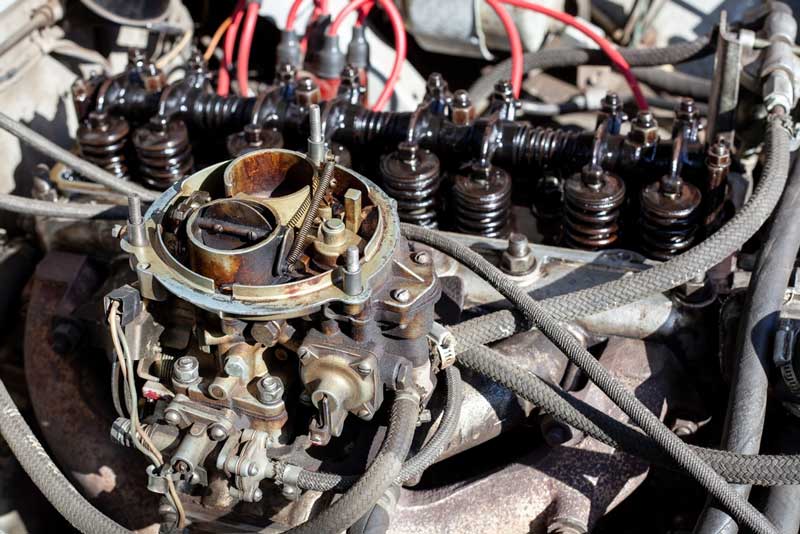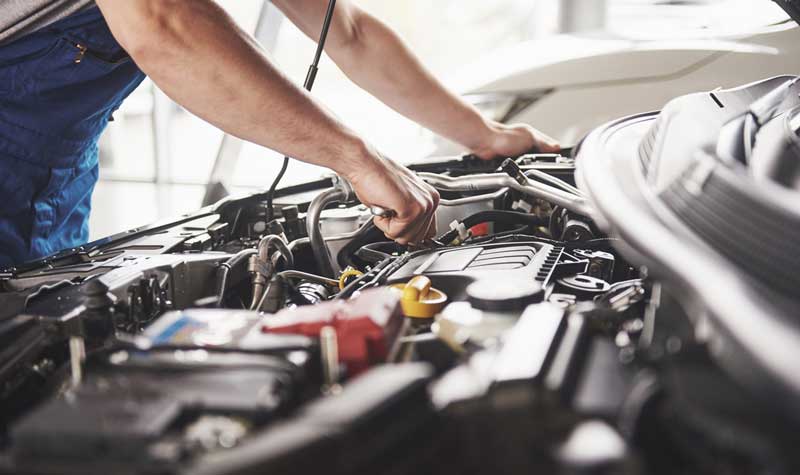Would you like to know how to clean a carburetor without removing it? What are the tools, methods, or techniques to clean a carburetor without removing it?
If you have any of these questions are your concerns, this guide will provide clear answers about cleaning the carburetor.
Yes, you can clean a carburetor without removing it, and it requires some steps, procedures and tools to get that done, all of which we will discuss in this guide.
We will also learn the cost of replacing the carburetor, and every other necessary information to keep a properly functioning carburetor.
Let’s get started!
How to Clean a Carburetor Without Removing It
Vacuum any loose dirt, debris, dust, grime and great the surface using a cordless and handheld vacuum. Lay on the surface at the base of the carburetor cloths or rags to catch runoffs. Apply the carburetor and choke cleanerin even and thin coats and allow it to settle and do its magic.
After some time, a carburetor collects grease, grime, debris, dirt, and dust. This causes clogs and blockages, making it difficult for a sufficient combo of air and fuel to reach your engine, further making the vehicle stop.
Although seeking professional assistance is a good option. Unfortunately, most times, it is not a time-saving and cost-effective solution.
Thus, you should learn how to clean your carburetor without removing it, at home.
Nonetheless, we have two ways of carburetor cleaning. The first is by using the carburetor cleaner, whereas the second is by pulling it out, then the parts will be cleaned one after the other.
Also Read: How to Tell if a Relay Is Bad (Expert Guide)
Tools Required for Cleaning a Carburetor Without Removing It
For one to clean the vehicle’s carburetor without the need to remove it, these materials will be needed:
- The wire brush or stiff-bristle brush
- Microfiber towels (two)
- The carburetor cleaner
- A cordless and handheld vacuum
- Slightly thick clothes or rags
- Some paper towels and napkins
- Simple hand tools for loosening nuts and bolts
- Safety goggles and a pair of gloves.
Notwithstanding that many of the listed materials are straightforward to pick, one must be extremely careful when buying a carburetor cleaner. It is also called a carburetor and choke cleaner. You must weigh numerous factors, before making a purchase; they include price, brand, simplicity of Use, compatibility, and formula. The product you choose should sufficiently match the entire criteria.
Procedure for Cleaning a Carburetor Without Removing It
Step 1: Wear protective gear, turn off your engine and remove any hoses, bottom bowl, linkages, and the housing of your air filter.
The first thing is to wear goggles and safety gloves. Then put on your face mask, and turn off your engine. Next, ensure that you safely disconnect the spark plug. The next thing is to find the housing of your air filter. Remove it to have access to the carburetor.
One might need to remove the entire surrounding linkages and hoses. You can make use of hand tools, for loosening any nuts and bolts. Take off the bowl at the carburetor’s bottom.
Now, make sure that your petcock is properly closed. If not, there will be a gas leak.
Place a few paper towels or napkins around the carburetor’s base, so that gas drips will drop on it. Excesses should be wiped. Then you can go to the subsequent step, having cleared a passageway to your dirty vehicle carburetor.
Step 2: Using a cordless or handheld vacuum, remove any grime, debris, loose dirt, and any impurities from the surface.
Make Use of a little cordless and handheld vacuum, to remove any form of surface-level filth. The vacuum should be set on a moderate or low setting, and carefully run through the compartment. Ensure that you carry out an exhaustive job. When you do this work properly, you will have less work later.
Step 3: Place cloths or rags at the base of the carburetor, to protect the surfaces and catch runoffs.
Change the napkin layer, with a slightly thicker layer of clothes or rags. It will aid in preventing surface harm or catching runoffs, especially those coated with paint.
Step 4: Apply the carburetor cleaner in thin form, and even coats. Allow it to settle and do its magic.
Afterward, get the choke cleaner and carburetor ready. Properly grip it, then hold it from its outer shield at half a palm’s length, for cleaning your outboard carburetor without the need to remove it. Shake it properly, then place your finger on its nozzle, prepared to hold down to the spritz.
Prepare a thin coat; do not ignore those secondary moving connections and points, especially your throttle area linkage. Then allow that cleaning solution to perform its magic. Exercise patience. It requires a few minutes.
To spray efficiently, take these leads:
- To clean the carburetor, your carb cleaner should be sprayed directly. Ensure that spray gets to the carburetor’s interior jets.
- Spraying directions should be followed appropriately. The carb cleaner tip should be placed at the center of the carburetor. Spray thoroughly.
- Begin from its center, then direct your hands over and around the carburetor.
- Always know that, while spraying, the engine and carburetor should be left running for deposits to be dislodged effectively.
- Only the carburetor should be sprayed. Do not make Use of the carb cleaner for other engine parts.
- For efficient cleanliness, it should penetrate your carburetor’s throat.
Step 5: Using the microfiber towel, and additional aid from a wire brush or stiff bristle brush, clean the filth and wipe that cleaning solution.
Use a new microfiber towel for wiping filth and that cleaning solution. If there are sludges or solid buildups, the stiff bristle brush can be used. You can also use the wire brush. Utilize extra carburetor cleaner that is required.
Note that it is normal for one to repeat the above steps, four or so many times. Keep doing so till the carburetor becomes clean. Pay attention and closely examine the openings.
Step 6: Using a dry towel, clean the carburetor and ensure it is completely dry.
Using another dry tool, wipe down the carburetor again. Ensure that excessive moisture is not left on it. Allow it to dry completely, either for an hour or more. For verification, it should not be damp when you touch it.
Step 7: At your carburetor’s base, remove the clothes, rags, and other tools for running an engine performance test.
Remove the cloths and rags placed at the base of your carburetor, and all other tools that were put to use. Then, turn on the engine to test how it functions. If it gives a better response than earlier before the clean-up, that is good.
If the case is contrary, repeat the same steps. If the engine is not the way you desire, you can clean your carburetor by removing it. Though it is a stressful task, most especially if, in the end, you will need to rebuild it, sadly, it might be the only remedy.
Step 8: Take back the bottom bowel, the housing of the air filter, linkages, and hoses to their original setup.
To complete the process, return the housing of the air filter, and put back everything that you temporarily disconnected during the first step.
Note that the carburetor has to be cleaned after some time. One need not see faulty signs before cleaning it. It is best to stay proactive about vehicle maintenance and care.

How Long Would It Take to Clean a Carburetor Using a Carb Cleaner
One should maintain and clean the carburetor frequently, to make sure that it works efficiently. The procedure required for cleaning it in and out is easy and will not exceed thirty (30) minutes or thereabout.
A Few Preventive Measures to Note
Everyone needs safety measures. In fixing any electrical or mechanical machine, one has to adopt safety measures. When one is cleaning his/her carburetor, he or she should hold onto these safety measures.
Gloves should be worn: Cover the hands using gloves, to avoid getting them greasy or oily. In addition, to avoid burns from hot parts.
Unplug: Ensure that the spark plug is unplugged, to avoid electrical shock when you are repairing the lawnmowers.
Handle carefully: Carefully operate any equipment that you use. Get the assistance of a professional, if you cannot use some of the equipment.
Examine the guards: Ensure the guards are secured and in place. Hence, you can repair your carburetor without causing damage to other parts.
Make Use of first aid box: Have an accessible first aid box in case of any unforeseen injury, so that you will not be disorganized in times of need.
What Does it cost to Replace a Carburetor?
The aftermarket carburetor is sold for about $100 – $1200. The amount depends on factors like warranty, material, brand, and other things. Depending on your location rates, labor ranges from $200 – $300.
Also Read: Engine Replacement Cost
Frequently Asked Questions – How to Clean a Carburetor Without Removing It
How long does carb cleaner take to dry?
Allow it for an hour or more, for it to dry totally. For verification, it should not be damp when you touch it.
Can you clean carbs without removing them?
Make Use of carburetor cleaner for removing debris, deposits, and clogs. Debris in the carburetor usually clogs the air and fuel passage stops the engine, and reduces performance. Fortunately, you can handle these issues easily, usually without having to remove the carburetor.
Can you spray carb cleaner directly into the carb?
Place the aerosol can tip inside the carburetor center, then directly spray inside your running carburetor. You are to do so as the carburetor runs, to allow that cleaner to go inside, keep your carburetor’s throat clean, and get rid of deposits found in its lower throttle plate.
How do I clean a small engine carburetor without removing it?
This can be done without removing the carburetor from its engine. Instead, begin by buying a commercial lawn mower carburetor cleaner in the spray can, making it easier to clean the inner part and the carb’s outer part.
Can you spray carb cleaner while the engine is running?
As you work the choke using your hand, spray on the two ends of your choke valve shaft. Then, spray around and down your carburetor’s throat, for deposits to be removed from that area of the throttle plate. Do not spray as the engine is off.
Is a carburetor easy to replace?
A carburetor wears out for numerous reasons. The carburetor may have to be changed when the engine is stalling, emitting black smoke, stumbling, hesitating, or finding it difficult to start. It may seem intimidating, but you should know that changing the carburetor is simple and requires easy steps.
Conclusion – How to Clean a Carburetor Without Removing It
Cleaning the carburetor is important for every engine. When you maintain the carburetor from time to time, it reduces the risk of additional issues.
It is hard to learn the steps of cleaning the carburetor without needing to remove it, but it is possible to learn it, so long as one gets the required tools and takes the appropriate steps.
Having read this article, you now know how to clean a carburetor without removing it and other needed information about cleaning your vehicle’s carburetors.

